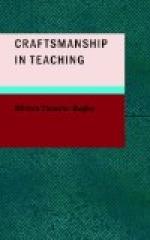Aside from the use of the dictionary, is the use of the helps that modern books provide for finding the information that may be desired,—indices, tables of contents, marginal and cross-references, and the like. These, again, are most significant in the work of the upper grades and the high school, and here again if we wish the skill that is developed in their use to be transferred, we must take pains to see that the pupil really appreciates their value,—that he realizes their time-saving and energy-saving functions. I do not know that there is any better way to do this than to let him flounder around without them for a little so that his sense of their value may be enhanced by contrast.
III
Another important step emphasized by the recent writers is the need for training children to pick out the significant features in the text or portion of the text that they are reading. This, of course, is work that is to be undertaken from the very moment that they begin to use books. How to do it effectively is a puzzling problem and one that will amply repay study and experimentation by the individual teacher. Much studying of lessons by teachers and pupils together will help, provided that the exercise is spirited and vital, and is not looked upon by the pupils as an easy way of getting out of recitation work. McMurry strongly recommends the marking of books to indicate the topic sentences and the other salient features. Personally, I am sure from my own experience that the assignment is all-important here, and that study questions and problems which can be answered or solved by reference to the text will help matters very much; but care must, of course, be taken that the continued use of such questions does not preclude the pupil’s own mastery of the art of study. To eliminate this danger, it is well that the pupils be requested frequently to make out their own lists of questions, and, as speedily as possible, both the questions made by the pupil and those made by the teacher, should be replaced by topical outlines. By taking care that the questions are logically arranged,—that is, that a general question refer to the topic of the paragraph, and other subordinate questions to the subordinate details of the paragraph,—the transition from the questions to the topical outline may be readily made. Simultaneously with this will go the transition in recitation from the question-and-answer type to the topical type; and when you have trained a class into the habit of topical recitation,—when each pupil can talk right through a topic (not around it or underneath it or above it) without the use of “pumping” questions by the teacher,—you have gone a long way toward developing the art of study.




